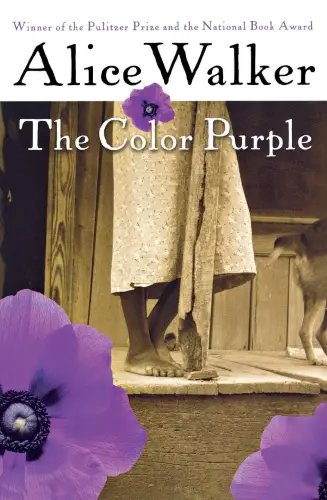The Color Purple
Book Author: Alice Walker
Summary reviewed by:
Terrence Timmons
Terrence Timmons
Analyst
Bachelor of Arts (BA), University Of California, Santa Barbara 2019
With over 4 years of experience as an analyst. Terrence Timmons is committed to analyzing summaries without compromising on quality.
The Color Purple: Summary
What would you do if the only way to survive was to stay silent? The Color Purple by Alice Walker is set in the deep South during the early 20th century, where we follow the heartbreaking journey of Celie, a poor African-American woman enduring unspeakable abuse at the hands of the men in her life. Told through a series of letters—first to God, then to her sister Nettie—Celie recounts her life from adolescence to adulthood. Over time, her correspondence reveals themes of racism, sexism, and the power dynamics between men and women in her community.
This novel isn’t just about survival; it’s about transformation. As Celie grows older, she begins to discover her worth, thanks to relationships with strong, rebellious women like Shug Avery, a blues singer, and Sofia, who defies male authority. Through these connections, Celie learns about love, resilience, and the possibility of reclaiming her power in a world determined to silence her. Walker’s prose brings out the heartache and beauty of Celie’s journey as she moves from a life of fear and oppression to one of self-realization and freedom.
Though The Color Purple stands alone and is not part of a series, it remains a literary classic, beloved for its powerful portrayal of Black womanhood and the enduring strength of the human spirit. If you’re seeking a novel that dives into themes of empowerment, transformation, and the bonds of sisterhood, this is a must-read.
Spoilers (watch a short ad to reveal spoilers)
The Color Purple: Genres
African American literature
Feminist literature
Historical fiction
Epistolary novel
Social commentary
The Color Purple: Main Characters
Celie: A resilient woman who endures years of abuse, Celie begins her journey as a victim of oppression but grows into a powerful, independent figure. She values love and loyalty, as seen in her deep connection with her sister Nettie and her ability to forgive those who have wronged her.
Nettie: Celie’s younger sister, driven by faith and determination. She becomes a missionary in Africa, holding onto hope that she will reunite with her sister. Her letters to Celie reflect her values of perseverance and education, as she teaches the children she raises about their heritage.
Shug Avery: A strong, free-spirited blues singer who defies societal expectations. She values independence and self-expression, evident in how she helps Celie discover her own sense of self-worth and teaches her about love and freedom.
Albert (Mr. ___): Celie’s abusive husband who undergoes a personal transformation later in the story. Initially, he values control and dominance, but by the end, he seeks redemption and humility, attempting to make amends for his past behavior.
Sofia: A proud and defiant woman married to Harpo, Albert’s son. She refuses to submit to male authority, valuing strength and autonomy. This is demonstrated when she physically stands up to Harpo and refuses to be beaten into submission.
The Color Purple: Themes
Racism: The novel portrays the systemic racism of the American South during the early 20th century. Celie and other Black characters face constant racial oppression, which limits their opportunities and subjects them to violence and injustice, such as Sofia’s wrongful imprisonment for standing up to a white woman.
Sexism and Gender Roles: Celie’s life is dominated by men who abuse her, illustrating the subjugation of women. Through characters like Shug Avery and Sofia, the novel explores how women challenge traditional gender roles and assert their independence.
Sisterhood and Female Empowerment: The bond between Celie and her sister Nettie, as well as her friendship with Shug and Sofia, represents the strength that women find in supporting each other. Celie’s growth into an empowered individual is driven by these relationships.
Sexual Identity: Celie’s relationship with Shug Avery leads her to explore her own sexual identity, offering an exploration of LGBTQ+ themes and the fluidity of desire, breaking away from heteronormative constraints.
Forgiveness and Redemption: Characters like Albert undergo significant personal growth. By the novel’s end, Celie’s ability to forgive Albert demonstrates the transformative power of forgiveness, even after immense suffering.
Religion and Spirituality: Initially, Celie writes letters to God, reflecting her belief in a higher power despite her suffering. Over time, her spiritual beliefs evolve, and she begins to see God as a force of nature and love rather than a distant figure.
The Color Purple: What You Need to Know
(Contains Spoilers: Perfect for readers seeking a quick review.)
The Color Purple centers on Celie, a poor African-American woman living in rural Georgia in the early 20th century. The novel begins with Celie, at the age of fourteen, being sexually abused by a man she believes to be her father. She becomes pregnant twice, and both children are taken away from her, leaving her with the belief that they are dead. Celie is forced into an abusive marriage with a man named Albert, whom she refers to as "Mister," where she continues to endure physical, emotional, and sexual abuse.
Celie’s life takes a turn when she meets Shug Avery, a glamorous blues singer who is also Albert’s longtime lover. Despite the complicated situation, Shug and Celie form a close bond. Shug helps Celie discover her self-worth and sexuality, encouraging her to stand up to Albert. Through Shug, Celie also learns that Albert has been hiding letters from her sister, Nettie, for years. Nettie, who had fled Albert’s advances, went to Africa as a missionary, where she has been raising Celie’s children with a couple she met.
Celie reads Nettie’s letters, discovering that her sister is alive and that her two children, Olivia and Adam, are well. The letters provide Celie with a new sense of hope and purpose. She confronts Albert about his actions and leaves him, moving to Memphis with Shug, where she starts her own business making pants, an expression of her newfound independence.
The Color Purple: Methodology
Our summary of The Color Purple stays true to its most important elements, focusing on its role in African American literature, feminist themes, and as an epistolary novel. By highlighting Celie’s transformation and relationships, we emphasize the deep emotional resonance at the heart of the novel. With its focus on sisterhood, oppression, and self-discovery, this book’s powerful themes are presented in a way that speaks to readers seeking insight and empowerment. We ensure our summaries are concise, accurate, and reflective of the book’s original tone, offering readers the essence without losing depth.


The Color Purple
Date Published: 1982
Disclaimer: As an Amazon Associate I earn from qualifying purchases.




